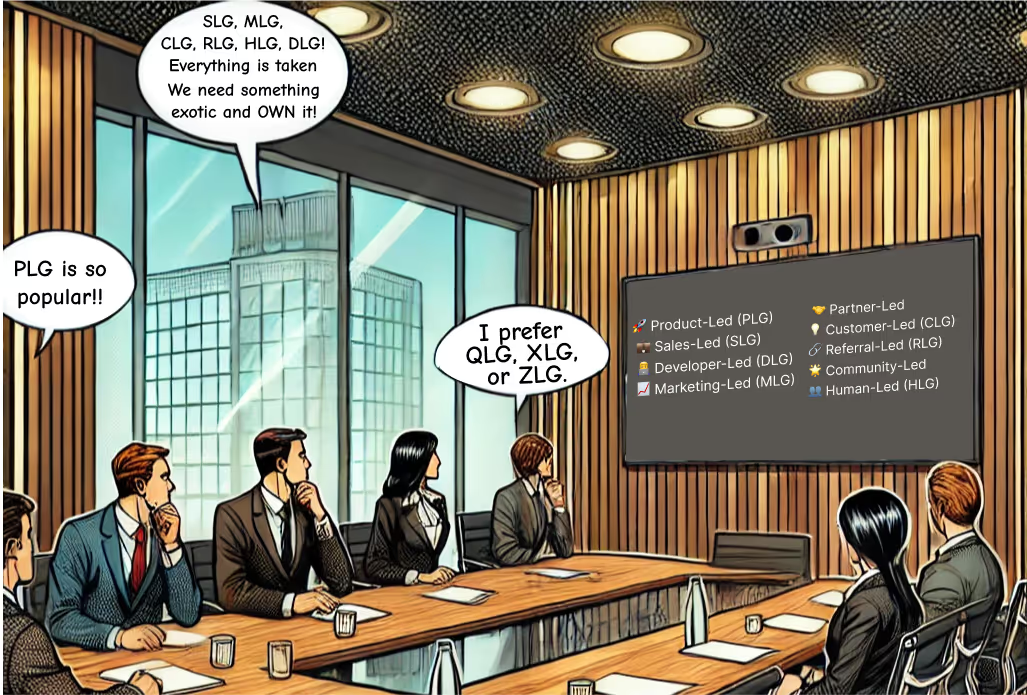Product-Led (PLG), Sales-Led (SLG), Developer-Led (DLG), Marketing-Led (MLG), Partner-Led,Customer-Led (CLG), Referral-Led (RLG), Human-Led (HLG), and Community-Led
Common Growth Strategies
Let's jump directly in. What are the various growth strategies, along with examples?
- Product-Led Growth, PLG, e.g., Figma, Slack, Zoom
- Sales-Led Growth, SLG, e.g., Palantir, Oracle, Cisco
- Marketing-Led Growth, MLG, e.g., HubSpot, Ahrefs
- Customer-Led Growth, CLG, e.g., Salesforce, Zendesk,
- Community-Led Growth, e.g., Notion
- Partner-Led growth, e.g., Spotify, Uber, Microsoft, and LinkedIn
- Referral-Led growth, RLG, e.g., Dropbox, Airbnb
- Developer-Led growth, DLG, e.g., Twilio
- Human-Led Growth, HLG, e.g., Every consulting firm & white-glove Customer Success companies
- AI-led growth is orthogonal and applies to all above strategies to drive efficiencies, scale, and experiences.
Each approach has unique characteristics and is suited to different business models and objectives.
Business Deploy Several Growth Strategies
It is important to note that a business applies several growth strategies simultaneously. For example, PLG pioneers like Slack, GitHub, and Zoom have Sales teams, i.e., th companies also incorporate an SLG motion.
Below is an AI generated summary of this old a16z video to drive this point.
The most significant trend in B2B today is characterized by a combination of bottom-up growth, often seen in consumer companies, and traditional sales methods, known as B2B growth sales.
This approach, which focuses on product excellence, creates a strong moat (a competitive advantage) for startups against incumbents. Despite the complexities and challenges in managing both growth and sales motions, this strategy has become essential across various verticals, significantly altering the B2B landscape.
However, to be effective, bottom-up organic growth and sales efforts must resonate and complement each other versus sales canceling out organic growth. This ensures that sales efforts uphold the organic growth achieved through product-led initiatives.
OpenView coined the term Product-Led Growth (PLG) in 2016, which initiated various "-led growth" Go-To-Market strategies. OpenView's fate is another story.
This article explores these strategies, compares their effectiveness, and discusses additional growth approaches.
What is Human-Led Growth (HLG)?
Human-Led Growth (HLG) emphasizes human interaction and relationship-building as the primary drivers of growth. This strategy leverages the power of personalized experiences and strong connections to drive business success.
Characteristics of HLG
- Personalized Customer Interactions: Direct communication and tailored recommendations.
- White-Glove Experiences: Offering premium, highly personalized service to ensure exceptional customer satisfaction.
- Relationship Building: Long-term relationship-building over short-term sales.
- High-Touch Engagement: Active engagement across various roles.
- Customer Experience Focus: Investing in training to provide exceptional service.
- Feedback Loop: Using customer feedback to improve services and products.
What is Product-Led Growth (PLG)?
Product-led growth (PLG) focuses on the product as the primary driver for acquiring, retaining, and expanding customers. Companies using PLG prioritize creating a product that provides significant value and a seamless user experience, allowing it to market itself through user satisfaction and word-of-mouth.
Characteristics of PLG
- Self-Service: Users can independently try, buy, and use the product.
- Freemium Models: Offering free versions or trials to attract users.
- User Experience Focus: Continuous improvement based on user feedback.
- Virality: Encouraging users to share and promote the product.
What is Sales-Led Growth (SLG)?
Sales-Led Growth (SLG) relies on a dedicated sales team to drive customer acquisition and revenue. This strategy is common in industries where products are complex, expensive, or require a personalized approach.
Characteristics of SLG:
- High-Touch Sales: Personalized interactions and relationship-building.
- Long Sales Cycles: In-depth consultations and negotiations.
- Customized Solutions: Tailored offerings to meet specific customer needs.
What is Marketing-Led Growth (MLG)?
Marketing-Led Growth (MLG) leverages marketing efforts to drive growth. This strategy emphasizes creating demand through brand awareness, content marketing, and lead generation.
Characteristics of MLG:
- Content Marketing: Producing valuable content to attract and educate potential customers.
- Brand Building: Establishing a strong brand presence to drive demand.
- Lead Nurturing: Using marketing automation to convert leads into customers.
What are Customer- and Community-Led Growth (CLG)?
Customer-led growth (CLG) centers on understanding and responding to customer needs and feedback. This strategy focuses on building strong customer relationships and leveraging customer insights to drive growth.
Customer-Led Growth
- Customer Insights: Gathering and analyzing customer feedback.
- Customer Success: Ensuring customers achieve their desired outcomes.
- Advocacy: Encouraging satisfied customers to refer others.
- Community Building: Creating a loyal customer community.
Community-Led Growth
- Engagement: Creating forums, events, and platforms for user interaction.
- Advocacy: Encouraging community members to become product advocates.
- Feedback Loop: Using community insights to improve the product.
What is Referral-Led Growth (RLG)?
Referral-Led Growth (RLG) focuses on leveraging existing customers to refer new ones. This strategy often includes incentives for both the referrer and the new customer.
Characteristics of RLG
- Incentives: Offering rewards for successful referrals.
- Ease of Referral: Making it simple for customers to refer others.
- Trust-Based: Leveraging the trust between the referrer and the new customer.
What is Partner-Led Growth?
Partner-led growth involves forming strategic partnerships to expand market reach and drive growth. This strategy leverages the strengths and networks of partner organizations.
Characteristics of Partner-led growth
- Strategic Alliances: Building partnerships with complementary businesses.
- Joint Marketing: Collaborating on marketing efforts to reach a broader audience.
- Resource Sharing: Sharing resources and expertise to enhance offerings.
Comparisons
Focus Areas for some growth strategies:
- HLG: Human interactions, personalized experiences, and white-glove service.
- PLG: Product quality and user experience.
- SLG: Sales team and personalized interactions.
- MLG: Marketing efforts and brand building.
- CLG: Customer insights and success and Community engagement and advocacy.
Strengths and Suitability:
- HLG: Ideal for businesses that thrive on personal relationships and high-touch engagement. Suitable for industries like consulting, luxury retail, and hospitality.
- PLG is best for scalable software solutions with low-touch sales. It is ideal for startups and SaaS companies where the product can drive viral growth.
- SLG: Suitable for complex, high-value products with longer sales cycles. Typical in enterprise software and B2B services.
- MLG: Effective for building brand awareness and generating high-quality leads. Ideal for industries with a strong content marketing potential.
- CLG: Excellent for fostering long-term customer relationships and maximizing lifetime value. Suitable for subscription-based models and businesses focusing on customer retention.
- Community-LG is good for building a loyal customer base and encouraging product advocacy. It is effective for companies with strong community engagement potential.
Challenges:
- HLG: Can be resource-intensive and scales much slower than other strategies.
- PLG: Requires a high-quality product and continuous improvement based on user feedback.
- SLG: Can be resource-intensive with longer sales cycles and higher acquisition costs.
- MLG: Needs a robust content strategy and ongoing investment in marketing efforts.
- CLG: Depends heavily on customer success and requires robust feedback mechanisms.
- Community-LG: Building and maintaining an active community can be challenging and time-consuming. Community discussions are often high-level or peripheral, and several companies, e.g., Apple, have strict policies regarding sharing in communities.
AI-led growth and the AI Agent Advantage
Your product, market, and business model dictate the right growth strategy. While HLG, PLG, SLG, MLG, RLG, Customer-LG, and Community-LG each offer unique advantages, many successful companies blend elements from multiple methods to achieve optimal results. For instance, even PLG companies like GitHub and Slack utilize sales teams to close large enterprise deals, demonstrating the importance of flexibility and integration in growth strategies.
AI-led growth strategy applies to all growth strategies and brings scale, efficiency, and vastly improved experiences.
AI-led growth is transformative and enhances and integrates with all existing growth strategies, driving efficiencies, scalability, and improved customer experiences. By leveraging AI, businesses can automate tasks requiring people, analyze data for insights, and provide personalized interactions at scale to every account and every user. AI can automate customer interactions, answer ad-hoc questions, optimize customer marketing campaigns, and make recommendations highly relevant. AI agents not only allow businesses to operate more efficiently but also enable them to offer superior customer experiences, ultimately leading to higher satisfaction and retention rates. By integrating AI into their growth strategies, businesses can stay competitive, agile, and better equipped to meet the evolving demands of their customers.
At Cast.app, we help our customers grow and preserve revenue without adding additional team members, yet engaging and influencing all accounts and all users, including inactive users, out-of-reach executives, and even decision-makers like CFOs. Our AI agents interact directly with your customers, handling thousands of tasks managed by customer success managers, account managers, renewal specialists, trainers, service professionals, and other customer-facing roles. This approach ensures efficient and scalable growth, allowing you to focus on providing expertise when needed, solving new challenges, and nurturing strong customer relationships.
By understanding and implementing these growth strategies, customer-facing executives in customer success, services, support, sentiment/survey/VOC, and expansion sales can drive sustainable growth and long-term success for their organizations.

